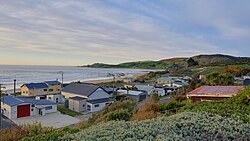Kaka Point
Kaka Point | |
|---|---|
Rural settlement | |
 Main street of Kaka Point | |
 | |
| Coordinates:46°23′S169°47′E/ 46.383°S 169.783°E | |
| Country | New Zealand |
| Region | Otago |
| Territorial authority | Clutha District |
| Ward | Catlins |
| Electorates |
|
| Government | |
| •Territorial authority | Clutha District Council |
| • Regional council | Otago Regional Council |
| •Mayor of Clutha | Bryan Cadogan |
| •Southland MP | Joseph Mooney |
| •Te Tai Tonga MP | Tākuta Ferris |
| Area | |
| • Total | 0.36 km2(0.14 sq mi) |
| Population (June 2024)[2] | |
| • Total | 250 |
| • Density | 690/km2(1,800/sq mi) |
| Time zone | UTC+12(New Zealand Standard Time) |
| • Summer (DST) | UTC+13(New Zealand Daylight Time) |
| Postcode | 9271 |
| Localiwi | Ngāi Tahu |
Kaka Pointis a small town at the northern edge ofThe Catlins,an area of the southernSouth IslandofNew Zealand.It is located 14km south ofBalcluthaand 8km north of the headland ofNugget Point.It has a seasonally fluctuating population, and there are numerous cribs (holiday homes) at the settlement. The settlement's best−known resident wasMāoripoetHone Tuwhare,who lived in Kaka Point for many years until he died in 2008. Kaka Point is named for thekākābird, whose signature call is "ka-aa."
There is a restaurant, a motel, bed and breakfasts, and camping grounds.[3]
Demographics
[edit]Kaka Point is described by Statistics New Zealand as a rural settlement. It covers 0.36 km2(0.14 sq mi),[1]and had an estimated population of 250 as of June 2024,[2]with a population density of 694 people per km2.It is part of the much largerCatlins statistical area.[4]
| Year | Pop. | ±% p.a. |
|---|---|---|
| 2006 | 201 | — |
| 2013 | 222 | +1.43% |
| 2018 | 231 | +0.80% |
| Source:[5] | ||
Kaka Point had a population of 231 at the2018 New Zealand census,an increase of 9 people (4.1%) since the2013 census,and an increase of 30 people (14.9%) since the2006 census.There were 114 households, comprising 114 males and 117 females, giving a sex ratio of 0.97 males per female. The median age was 54.5 years (compared with 37.4 years nationally), with 33 people (14.3%) aged under 15 years, 12 (5.2%) aged 15 to 29, 120 (51.9%) aged 30 to 64, and 63 (27.3%) aged 65 or older.[5]
Ethnicities were 96.1% European/Pākehā,3.9%Māori,and 1.3% other ethnicities. People may identify with more than one ethnicity.[5]
Although some people chose not to answer the census's question about religious affiliation, 53.2% had no religion, 39.0% wereChristian,1.3% wereBuddhistand 1.3% had other religions.[5]
Of those at least 15 years old, 33 (16.7%) people had a bachelor's or higher degree, and 54 (27.3%) people had no formal qualifications. The median income was $35,600, compared with $31,800 nationally. 27 people (13.6%) earned over $70,000 compared to 17.2% nationally. The employment status of those at least 15 was that 99 (50.0%) people were employed full-time, 30 (15.2%) were part-time, and 3 (1.5%) were unemployed.[5]
References
[edit]- ^ab"ArcGIS Web Application".statsnz.maps.arcgis.Retrieved22 January2022.
- ^ab"Aotearoa Data Explorer".Statistics New Zealand.Retrieved26 October2024.
- ^"Fiordland & Southland travel".
- ^2018 Census place summary: Catlins
- ^abcde"Statistical area 1 dataset for 2018 Census".Statistics New Zealand. March 2020. 7029114.
